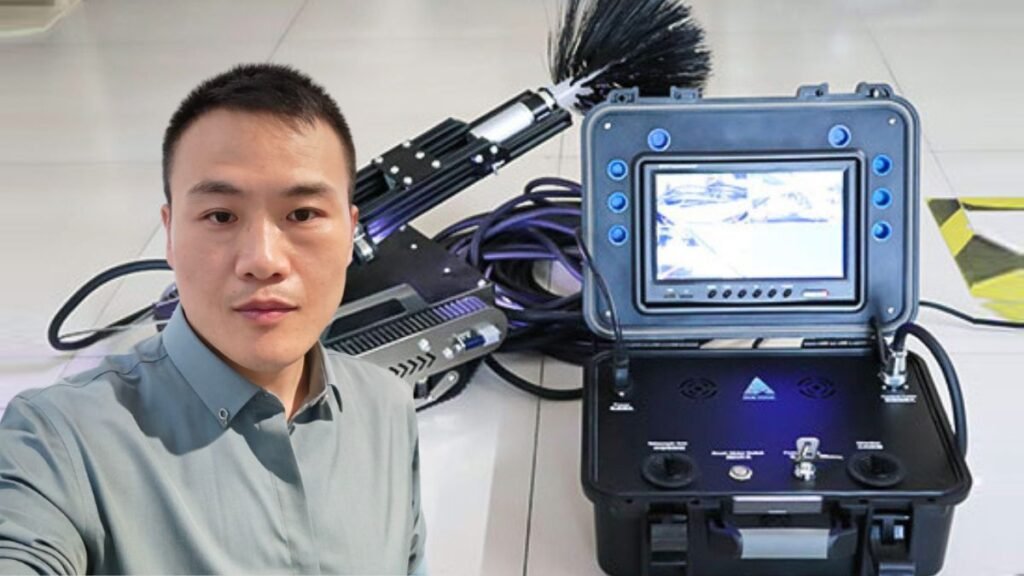Ever wondered why your workshop feels like a dust storm in the Sahara? Dust is the unwanted guest in every woodworker’s space. But don’t worry! I’m here to help you find the perfect portable dust collector. This will make your workshop cleaner and healthier. Ready to breathe easier and work smarter? Let’s get started!
Dust collectors are more than fancy vacuum cleaners. They’re game-changers for your workspace. The right system can keep those pesky particles away from your lungs and equipment. Did you know dust buildup can increase equipment maintenance costs by 30% in industrial settings? These particles are a real threat to your wallet and health!
Not all dust is the same. It ranges from harmless sawdust to dangerous particles. About 70% of dust types are low-risk, 20% medium-risk, and 10% high-risk, including carcinogens. Choosing the right dust collector is key to keeping your space safe and efficient.
Portable dust collectors come in different shapes and sizes, each with unique abilities. Some, like the Oneida Dust Gorilla, can separate 99% of dust. They also have SMART Boost® technologies for strong suction power, even over long distances or with multiple blast gates.
Whether you’re a weekend warrior or a full-time woodworker, this journey will change your workshop. Your lungs and cleaning schedule will thank you!
Key Takeaways
- Portable dust collectors significantly improve workshop air quality and safety
- Dust types vary in risk levels, from harmless to potentially carcinogenic
- High-efficiency systems can capture over 99% of dust particles
- Proper dust collection reduces equipment maintenance costs
- Advanced features like SMART Boost® technology enhance collection efficiency
- Choosing the right collector depends on your specific workshop needs
Understanding Portable Dust Collectors
Portable dust collectors are key for keeping air clean in workshops and construction sites. They work like air purifiers or shop vacs, catching dust and debris. This makes the work area safer.
What is a Portable Dust Collector?
A portable dust collector is a small, mobile device that cleans the air. It’s different from fixed dust extractors because it can be moved around. It has a strong motor, a filter system, and a container to hold the dust.
These devices can catch particles as small as 0.3 microns, thanks to their HEPA filters.

Benefits of Portable Dust Collectors
Portable dust collectors offer many benefits:
- They improve air quality by removing harmful particles that can stay in the air for up to 30 minutes.
- They are flexible and easy to move and connect to different tools.
- They are cost-effective, priced between $300 to $1,000, which is less than industrial models.
- They are great for handheld tools, removing dust directly at the source.
Key Features to Consider
When picking a portable dust collector, look at these important features:
- Airflow capacity: For a typical two-car garage shop, aim for at least 600 cubic feet per minute (CFM) per unit.
- Filtration efficiency: Choose models with HEPA filters or those rated at 2 microns or less.
- Noise levels: Opt for models with backward curved impeller designs for quieter operation.
- Portability: Consider weight and wheel design for easy mobility.
Understanding these features helps you pick the right portable dust collector. This ensures a cleaner and healthier work environment.
Types of Portable Dust Collectors
Dust collectors come in different types, each tackling specific dust challenges. Let’s look at the main categories for cleaner air.
Cyclone Dust Collectors
Cyclone dust collectors use cyclonic separation to clean the air. They create a vortex that spins dust-laden air. This forces heavier particles to the edges, while clean air goes through the center. This method is great for construction sites, capturing larger particles.

Baghouse Dust Collectors
Baghouse collectors are key in industrial settings. They use fabric filters to catch dust particles as air flows through. These systems handle a lot of dust-laden air, perfect for big operations. Baghouses use pulse-cleaning to release dust into a hopper, keeping them efficient.
Cartridge Dust Collectors
Cartridge dust collectors are versatile and used in many industries. They’re great for welding, woodworking, and food making. These collectors use pleated filters to catch even small dust particles. Some models use HemiPleat® technology for better filtering.
Portable dust collectors are great for on-site work. They use less power than stationary models and are used in many industries. They may not handle as much dust as stationary ones, but they’re essential for improving air quality.
Choosing the right dust collector depends on your needs. Think about the dust type, air volume, and your workspace. The right choice improves air quality, equipment life, and worker health.
How Portable Dust Collectors Work
Portable dust collectors are key for keeping air clean in workspaces. They use strong motors to pull in air filled with dust. This air then goes through filters to clean it.
Filtration Mechanisms
The core of a portable dust collector is its filter system. Some use cyclonic action to remove big particles. Others use HEPA filters to catch tiny dust.
HEPA filters can catch particles as small as 0.3 microns. This is smaller than a human hair! This level of filtering is vital for clean air and worker health.
Airflow Dynamics
Airflow is key in dust collection. A good system keeps suction strong even when the bin fills up. This steady airflow is essential for removing dust.
Central dust collection systems often have better airflow over time compared to portable ones.
Collection Techniques
Dust collectors use different ways to collect dust. Some use simple bags, while others use cyclone separators. The Oneida Dust Deputy uses a two-stage process for better efficiency.
The first stage catches big particles, and the second catches finer dust.
| Feature | Portable Dust Collectors | Central Dust Collection Systems |
|---|---|---|
| Filter Life | Shorter due to manual cleaning | Longer with automatic pulse cleaning |
| Airflow Consistency | May vary over time | More consistent for longer periods |
| Space Efficiency | Takes up floor space | Can replace multiple portable units |
| Application Versatility | Limited to smaller volume collection | Suitable for various applications |
Knowing how these systems work helps choose the right one. Whether it’s a portable unit or a central system, the right dust collector improves air quality and safety.
For more info on portable dust collectors and their benefits, check out industry resources. Keeping a dust-free environment not only makes things cleaner but also lowers fire risks and health dangers from inhaling fine particles.
Choosing the Right Size
When picking a dust collector, size matters a lot. Let’s explore how to find the right one for your workshop.
Assessing Your Needs
First, look at your workspace and tools. Small workshops might need a dust collector with 300-700 CFM. Medium spaces with heavy tools require 700 to 1500 CFM. Large industrial areas might need up to 2000 CFM for good wood dust collection.
Calculating Airflow Requirements
For non-hazardous dust, aim for 80 ft/minute air movement. In a 10 ft x 10 ft area, this means 8,000 CFM. Hazardous dust needs 100 ft/minute air speed. Make sure your dust collector has at least 4000 FPM airspeed in ducts for dust transport.
Space Considerations
Think about static pressure too! Most small to medium workshops need 8-10 inches of water column (WC). If you have long ducts or many bends, you might need more. For dust collectors under 1500 CFM, a 1.5 HP motor is usually enough. Systems over 1500 CFM need 3 HP or more motors for best airflow.
Getting the size right is critical for dust control. With nearly 50 years of experience, experts say following local rules and codes is vital12. By carefully checking your needs and space, you’ll find the ideal dust collector for your woodworking or jobsite dust control.
Essential Features to Look For
Choosing the right portable dust collector can greatly improve your workshop. Let’s look at the key features to find the best dust collector for your projects.
Filter Efficiency Ratings
HEPA filtration is a big deal in dust collectors. These filters catch particles as small as 0.5 microns, keeping your space clean and your health safe. For tasks that create fine dust, choose collectors with high-efficiency filters to handle airborne particles well.
Noise Levels
A loud dust collector is a nuisance. Look for models with features to reduce noise. Festool vacs, for example, are quieter than traditional shop vacs, making your work area more comfortable.
Mobility Options
Being able to move your dust collector around is important. Models with wheels, handles, and compact designs are great for this. They’re perfect for small workshops or construction sites where dust collection needs change often.
- Dust type and volume
- Required filtration level
- Available space
- Noise tolerance
- Mobility needs
The right dust collector can greatly improve air quality and reduce health risks. It can help prevent diseases like COPD, asthma, and exposure to harmful dusts like silica and asbestos.
| Feature | Importance | Considerations |
|---|---|---|
| HEPA Filtration | High | Captures particles as small as 0.5 microns |
| Noise Level | Medium | Look for noise-reducing features |
| Mobility | High | Wheels, handles, compact design |
| Capacity | Varies | Based on dust volume produced |
By focusing on these key features, you’ll find a dust collector that keeps your workspace clean and safe. It will also make your work more efficient. Happy dust collecting!
Understanding Dust Collection Efficiency
Dust collection efficiency is key for clean air and worker health on construction sites. We’ll explore what makes dust collectors, like negative air machines, effective.
Common Dust Particle Sizes
Dust particles vary in size. For example, sanding walnut at 180 grit creates dust around 150 µm. This is bigger than a straight pin at 127 µm. Knowing these sizes helps pick the right dust collector.
Importance of CFM (Cubic Feet per Minute)
CFM measures air movement in dust collectors. More CFM means better dust collection. A recent filter cleaning boosted CFM by 50%, showing maintenance’s value.
When picking a dust collector, think about your shop’s layout, ceiling height, and tools. This helps choose the right CFM for your needs.
Static Pressure Considerations
Static pressure impacts a dust collector’s performance. It’s the air resistance in pipes and hoses. Finding the right balance between CFM and static pressure is essential for your setup.
| Dust Collector Type | Efficiency Rate | Best Application |
|---|---|---|
| Baghouse | 99% | General industrial use |
| Cyclone | 80-90% | Woodshops, paper mills |
| HVLP Systems | Varies | Chip collection |
| HPLV Systems | Varies | Fine dust collection |
Baghouse dust collectors remove 99% of particles, making them great for air quality. Cyclone systems are popular in woodworking, using centrifugal force to separate dust.
The right dust collection system is vital for air quality and equipment life. Uncontrolled dust can damage motors, shortening equipment life. By understanding these factors, you can select the best dust collector for a clean, safe workspace.
Navigating the Market
Choosing a portable dust collector or shop vac requires understanding the market. We’ll look at top brands, prices, and warranties to guide your choice.
Leading Brands in Portable Dust Collectors
Several big names dominate the dust extractor market. Donaldson Company and Illinois Tool Works lead with sales of $3.3 billion and $14 billion. Sly Filters and Spraying Systems also play key roles, with Spraying Systems earning over $300 million. These brands offer a variety of dust collectors, from small shop vacs to large industrial models.
Pricing Factors
The price of a dust collector depends on several things. The market for Modular Dust Collectors is growing fast, with a 6% CAGR from 2024 to 2031. When setting a budget, think about the dust’s size, density, and how abrasive it is. These details affect the filtration needed, which changes the cost.
Warranty and Support
Warranty terms for dust collectors vary a lot, so it’s key to know them before buying. Look for suppliers with quick repair services to keep your work flowing. The time lost to repairs can hurt your business, which needs dust collection all the time. A good dust extractor or shop vac with solid support can save you money and stress in the long run.
When shopping, keep an eye on new tech like IoT and AI in dust collection. These advancements make systems more efficient by monitoring and predicting maintenance needs, which can save money over time.
Installation and Setup
Setting up your dust collector is key for clean woodworking and good air quality. We’ll cover the main steps to keep your workshop tidy and safe.
Positioning the Dust Collector
Think about where to put your dust collector. It should reach all tools and not block your way. Mount it at least 65 inches off the floor.
Use two 36-inch long 2×4 cleats and lag bolts for support. This setup helps collect dust well without getting in the way.
Connecting to Power
Most dust collectors plug into regular outlets. But, some big ones might need their own circuits. Check your dust collector’s needs before you start.
For example, a 2 HP Harbor Freight dust collector costs about $450. It might need special power.
Maintenance for Optimal Performance
Keeping your dust collector in top shape is important. Clean filters, empty bags, and check for leaks regularly. Upgrades can also help:
- Rikon 60-200 impeller upgrade: $110
- Wynn filter upgrade: $200
- DIY blast gates (x11): about $40
For the best setup, use PVC piping 42 inches above the floor. Avoid 90-degree turns for better airflow. Use two 45-degree elbows instead. This way, you get great dust collection and air quality.
Safety Considerations
Portable dust collectors are all about safety. Let’s look at key points to keep you and your workspace safe.
Ensuring Air Quality
Good air quality is essential for health and work. Portable dust collectors with HEPA filters are great at cleaning the air. They can catch dust as small as 1 µm, making the air much cleaner.
Dust Explosions and Mitigation
Many don’t know that fine dust can be explosive. Dust fires and explosions need fuel (dust), oxygen, and a spark. To avoid these risks:
- Use vertically-mounted cartridge filters to keep dust down
- Keep filters clean to avoid overloading
- Use flame-retardant filters and spark arrestors in risky areas
Worker Safety Practices
Keeping workers safe is a top priority. The World Health Organization says dust can cause serious health issues. Here are some important steps:
- Wear the right PPE like dust masks and safety glasses
- Use self-dumping hoppers to lower fire risks and improve collector performance
- Follow strict rules for entering confined spaces to service dust collectors
A safe workshop is a productive one. By following these safety tips and using top-notch portable dust collectors, you’re not just cleaning the air. You’re also protecting health and preventing dangers.
Maintenance and Care
Hey there, dust-busting buddies! Let’s talk about keeping your portable dust collector in top shape. It’s like giving your trusty shop vac or dust extractor a spa day. A little TLC goes a long way!
Regular Cleaning Protocols
First things first, let’s talk cleaning routines. Daily checks of the differential pressure across filters are a must-do to keep your system running smoothly. Don’t forget to peek at your hopper weekly – you want to make sure it’s emptying properly. And hey, while you’re at it, give your fan a once-over each week. Look out for any weird vibrations or amp draw issues.
Filter Replacement Guidelines
Now, onto filters – the unsung heroes of your dust collector. Some cartridge filters are real troopers, lasting up to 2 years before needing a swap. But if you’re dealing with heavy-duty dust, you might need to change them more often. Keep an eye on that differential pressure – if it hits around 5″ WG, it’s time for new filters. A sudden drop in pressure? That could mean a hole in your filter or a leaky gasket.
Troubleshooting Common Issues
Got some dust collector drama? No worries! If your system’s not pulling its weight, check those diaphragm and solenoid valves. They should be pulsing together like a well-choreographed dance. And don’t forget about those door seals and gaskets – damaged ones can let dust escape and mess with your airflow. For more in-depth maintenance tips, check out this handy guide. Remember, a happy dust collector means cleaner air and a safer workspace!
FAQ
What is a portable dust collector?
A portable dust collector is a mobile vacuum system. It captures dust, wood chips, and fine particles. This helps keep the air clean and reduces health risks from dust.
How does a cyclone dust collector work?
A cyclone dust collector uses centrifugal force to separate particles. Air spins inside, pushing heavier particles to the sides and bottom. Cleaner air exits through the top.
What’s the difference between a shop vac and a dust extractor?
A dust extractor is more powerful than a shop vac. It has better filters, including HEPA, and is made for constant use in woodworking and construction.
How do I calculate the CFM requirements for my workshop?
To find CFM needs, add up the CFM of your tools. Most tools have CFM ratings. Aim for a dust collector with at least 350 CFM per tool used at once.
What is static pressure and why is it important?
Static pressure is the air resistance in a dust collection system. It’s key because it affects efficiency. A dust collector must be strong enough to handle your setup’s static pressure.
Are portable dust collectors noisy?
Noise levels vary among models. Some are loud, others quieter. Look for models with 70-80 dB ratings for less noise. Always wear hearing protection.
How often should I clean or replace the filters in my dust collector?
Cleaning frequency depends on use. Clean filters every few weeks and replace every 6-12 months. Check your manufacturer’s advice and inspect filters for damage or buildup.
Can a portable dust collector help with jobsite dust control?
Yes! Portable dust collectors are great for jobsite dust control. They can be moved around to capture dust, improving air quality and reducing cleanup time.
What’s the importance of HEPA filtration in dust collectors?
HEPA filtration is key for catching small, harmful dust particles. It can trap particles as small as 0.3 microns, keeping your air quality healthy.
Are there any safety concerns with using portable dust collectors?
While dust collectors improve safety, there are concerns. Make sure to ground properly to avoid static buildup. Regular maintenance is important to prevent dust accumulation. Be aware of dust explosion risks in extreme cases. Always follow safety guidelines from the manufacturer.






